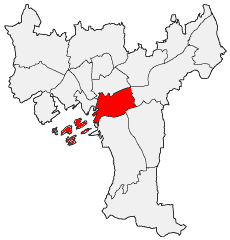This article needs additional citations for verification. (July 2014) |
Bydel Gamle Oslo | |
|---|---|
 Grønland og blokkene på Enerhaugen sett fra Ekeberg | |
 | |
| Country | Norway |
| City | Oslo |
| Area | |
• Total | 7.45 km2 (2.88 sq mi) |
| Population (2020[1]) | |
• Total | 58,671 |
| • Density | 7,875/km2 (20,400/sq mi) |
| Time zone | UTC+1 (CET) |
| • Summer (DST) | UTC+2 (CEST) |
| ISO 3166 code | NO-030101 |
| Website | bgo.oslo.kommune.no |
Gamle Oslo is a borough of the city of Oslo, Norway. The name means "Old Oslo", and the district contains Old Town.
The borough has several landmarks and large parks, including the Edvard Munch Museum, the Botanical Gardens and a medieval park.
During the time that present Oslo was named Christiania, this area was called Oslo. H. P. Lovecraft alludes to the fact in his story The Call of Cthulhu:
One autumn day I landed at the trim wharves in the shadow of the Egeberg. Johansen's address, I discovered, lay in the Old Town of King Harald Hardrada, which kept alive the name of Oslo during all the centuries that the greater city masqueraded as "Christiana".
Neighborhoods of Oslo belonging to this borough are:
- Ekebergskråningen
- Enerhaugen
- Ensjø
- Etterstad
- Gamlebyen
- Grønland
- Helsfyr
- Kampen
- Tøyen
- Vålerenga
- Valle-Hovin
The borough also includes islands and islets in the Oslofjord: Kavringen, Nakholmen, Lindøya, Hovedøya, Bleikøya, Gressholmen, Rambergøya, Langøyene and Heggholmen. In the Oslo borough reform in 2004, the borough Helsfyr-Sinsen was removed, and the neighborhoods Ensjø, Etterstad Valle-Hovin and Helsfyr were included in Gamle Oslo.
In the municipal election of 2007 all borough councils became elective, until then most had been appointed by the city council. Labour became the largest party with 5 representatives, the Socialist Left have 3, the Conservatives, Liberals and the Red Electoral Alliance 2 each, and the Progress party 1.
- ^ Municipality of Oslo (2020). "Befolkningen etter bydel, kjønn og aldersgrupper 1.1.2020" (in Norwegian). Archived from the original on 20 May 2020. Retrieved 29 April 2020.
